平成29年12月16日 土曜日号
“結晶 平成3年”
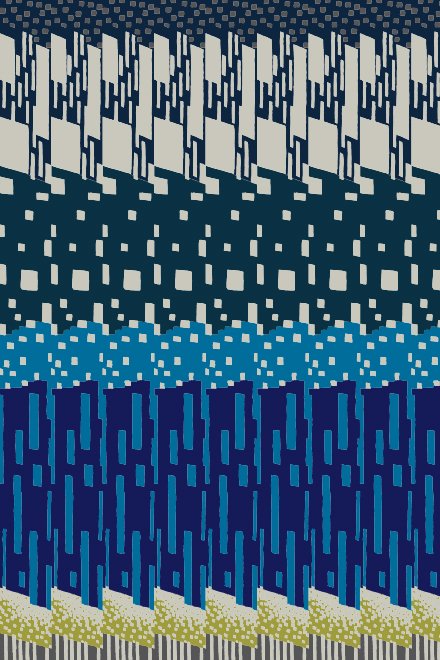
太古の昔からの土が堆積し
固まって石となる。
自然のものとは思えぬ
幾何学的な模様は
魂に呼びかけてくるものがある
(脇阪 克二)
"Crystals"(1991,by Katsuji Wakisaka)
Eearth or solid materialsaccumulate into crystals from the beginning of history.
Those well-defined geometric shapes, thoroughly intriguing me.
It is hard to believe they are made by nature.
| English translation by LI XIAO XIAO |
"Crystal"(1991, par Katsuji Wakisaka)
La terre s’amoncèle depuis les temps anciens,
durcissant jusqu’à l’état de pierre.
Il en existe avec des formes géométriques telles
qu’elles donnent l’impression de ne pas avoir été
créés par Dame Nature.
| Traduction française par Jean-Baptiste Fauvel Matsumoto |
"結晶"(1991, 胁阪 克二)
千年萬年前,塵土堆積,凝成結晶。
幾何學的迷人模樣,奪魂的美。
難以置信是自然造物者的作品。
| 中译 : 李 瀟瀟 |
→こちらのテキスタイルデザイン商品
(Textile products with this pattern)
平成29年12月09日 土曜日号
“枡 昭和55年”
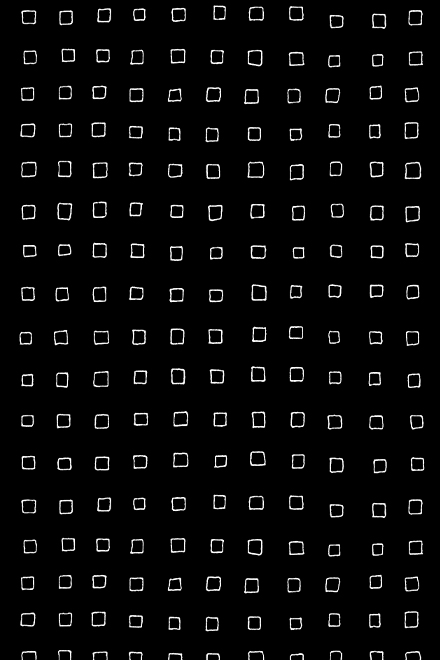
僕は単純に並べていく模様はとても好きだ。
これもそのひとつ。
エンピツで描いた線の感じが何となく
残っているところがポイントかもしれない。
(脇阪 克二)
"Masu / Little boxes"(1980,by Katsuji Wakisaka)
Arranging things side by side is one of my tendency to design.
Masu, or little square wooden boxes is a typical pattern.
You can tell that the remaining trace of pencil painting is the point of this textile design.
| English translation by LI XIAO XIAO |
"Masu"(1980, par Katsuji Wakisaka)
J’aime beaucoup les motifs alignés simplement les uns après les autres.
Celui-ci en fait parti.
Le détail intéressant est peut-être cette impression de coup de crayon
tracé à la main présent sur le design.
| Traduction française par Jean-Baptiste Fauvel Matsumoto |
"枡"(1980, 脇阪 克二)
我很喜歡用簡單排列的方式進行創作
這幅「枡」就是是其中之一
微妙地保留了鉛筆描繪的痕跡
是它的獨特之處
| 中譯 : 李 瀟瀟 |
→こちらのテキスタイルデザイン商品
(Textile products with this pattern)
平成29年12月06日 水曜日号
“源(げん) 平成23年”
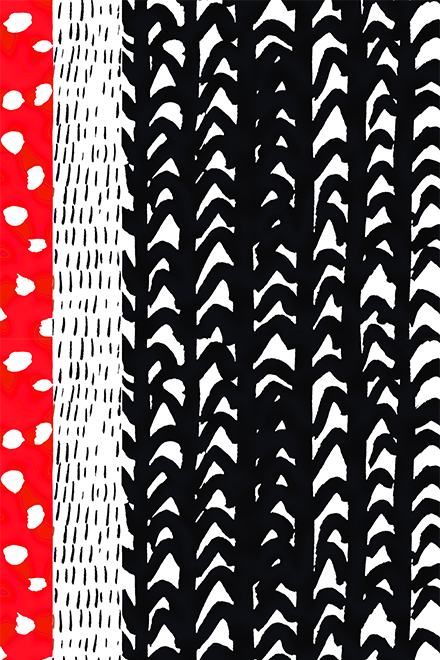
山に分けいって道なき道を奥へ奥へと進んでいく。
もうあきらめようかと思ったころ
遠くでかすかな音が聞こえてきた。
近づくにつれて水の流れが見えてくる。
岩の間から清らかな水がこんこんと湧き出ている。
これがあの大きな川の源なのか。
(脇阪 克二)
"Water Source"(2011,by Katsuji Wakisaka)
Vally path,
Lead me deep into the mountain,
As there is no way out.
Suddenly, I heard the murmur of water.
As I drew nearer, i saw it to be flowing between rocks.
And I wonder, it might be the water source of a grand river.
| English translation by LI XIAO XIAO |
"La source"(2011, par Katsuji Wakisaka)
Au coeur de la montagne, je suis un petit chemin qui s’enfonce de plus en plus.
Juste au moment où je pensais à faire chemin inverse,
J’entends au loin un bruit indistinct.
En s’en rapprochant apparait un cours d’eau.
D’entre les rochers jaillit de l’eau pure.
Serait-ce la source de ce grand fleuve?
| Traduction française par Jean-Baptiste Fauvel Matsumoto |
"源"(2011, 胁阪 克二)
我沿著山路一直向前,
越走越深。
就快要放棄找尋出路的時候,
突然聽見遠處傳來流水聲。
尋聲走近,岩石閒湧出清流几股。
這些清澈的細流,我想
或許也是哪條大江河的源頭吧。
| 中译 : 李 瀟瀟 |
→こちらのテキスタイルデザイン商品
(Textile products with this pattern)
平成29年12月03日 日曜日号
“小さな花 平成17年”
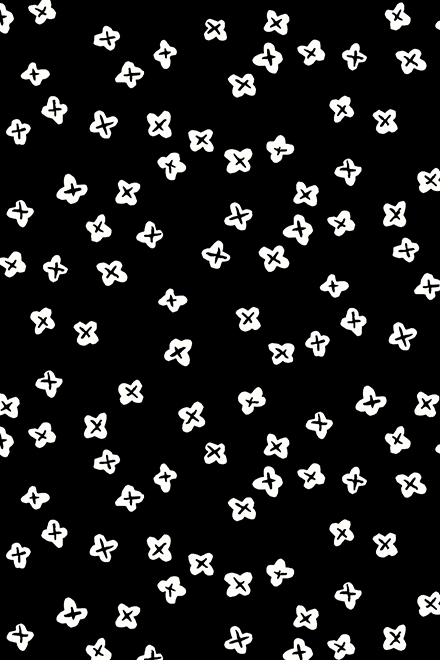
緑の中に小さな花が咲いている。
あっちを向いたりこっちを向いたり
仲良く並んでいたり
ひとりポツンと離れていたり。
みんな小さな口を精一杯あけて
夢中になって歌っている。
(脇阪 克二)
"Tiny flowers"(2005,by Katsuji Wakisaka)
Tiny flowers bloom in green,
Look around this way and that.
Sometimes line up in harmony with each other,
Sometimes leave someone out of the group.
Look! They open their small mouths and singing intently.
| English translation by LI XIAO XIAO |
"Petites fleurs"(2005, par Katsuji Wakisaka)
Dans la verdure fleurissent des petites fleurs.
Se tournant de tous les côtés,
Toutes gentilles entre elles, ou bien esseulées.
Leurs pétales grands ouverts de toute leur force
elle chantent comme dans un rêve.
| Traduction française par Jean-Baptiste Fauvel Matsumoto |
"小花"(2005, 胁阪 克二)
小花朝著不同方向,
開在一大片綠色中。
時而要好地排成一排,
時而孤立一朵兀自站在遠處。
小傢伙們奮力張嘴,忘我歌唱。
| 中译 : 李 瀟瀟 |
→こちらのテキスタイルデザイン商品
(Textile products with this pattern)
平成29年11月25日 土曜日号
“花そすう 平成29年”
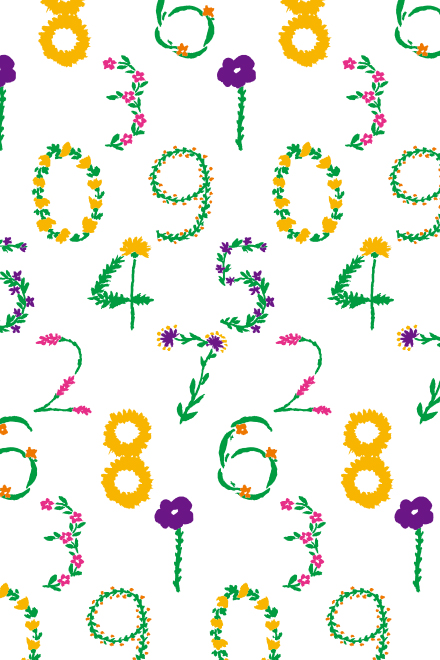

SOU・SOUには 数字をテキスタイルに
したものが いくつかあり どれも人気がある。
今回は 数字を花で あらわしてみた。
花の装飾性と 数字の幾何学的な
形が 今までのものとは違った
かわいい 世界を見せている。
(脇阪 克二)
"Floral numbers"(2017,by Katsuji Wakisaka)
In SOU・SOU, there're several popular textile designs about Numbers.
But this time, I use flowers to express numbers.
By combining decorative flowers and geometric numbers in a creative way,
It may open up a lovely new world.
| English translation by LI XIAO XIAO |
"Chiffres floraux"(2017, par Katsuji Wakisaka)
Chez SOU・SOU, il existe de nombreux designs avec des chiffres,
qui ont beaucoup de succès, chacun dans leur genre.
Cette fois-ci, nous avons dessiné ces chiffres en fleurs.
L’aspect décoratif des fleurs et la géométrie des chiffres
nous montrent un monde attendrissant, jamais vu jusqu’alors.
| Traduction française par Jean-Baptiste Fauvel Matsumoto |
"花數字"(2017, 脇阪 克二)
SOU・SOU織紋中的數字圖案很受歡迎
這次我用具有裝飾性的花
來表現幾何形狀的數字
創造一個前所未有的可愛宇宙
| 中譯 : 李 瀟瀟 |
→こちらのテキスタイルデザイン商品
(Textile products with this pattern)
平成29年11月22日 水曜日号
“菊唐草 平成18年”
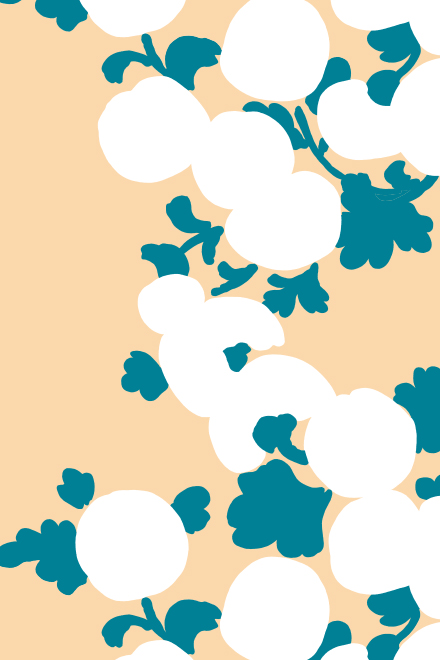
これは僕が好きな光琳の写し。
大胆さと繊細さ、思い切って省略していながら
菊の美しさが匂いたってくる風情がある。
光悦、宗達、光琳、乾山は日本美術の白眉であり、
永遠の憧れだ。
(脇阪 克二)
"Chrysanthemum arabesque"(2006,by Katsuji Wakisaka)
This is a copy of my favorate Korin chrysanthemum, a pattern of the Rimpa School.
Beauty and fragrance of chrysanthemum are expressed by a boldly omission and delicate description.
I do admire thoes Rimpa artists including Koetsu HONAMI, Sotatu TAWARAYA, Korin OGATA and Kenzan OGATA.
| English translation by LI XIAO XIAO |
"Chrysanthème arabesque"(2006, par Katsuji Wakisaka)
Voici une réplique de mon adoré Kōrin.
Tout en mettant de côté sa bravoure et sa délicatesse,
il y a comme une odeur de beauté dans l’air.
Je ne me lasserai jamais de l’élite de l’art japonais
dont font parti Kōetsu, Sōtatsu, Kōrin et Kenzan.
| Traduction française par Jean-Baptiste Fauvel Matsumoto |
"菊唐草"(2006, 脇阪 克二)
這幅織紋是我對鍾愛的光琳派畫風之摹寫
大膽又纖細,精煉至極
將菊的五感風情完美地傳達
以阿彌光悅、俵屋宗達、尾形光琳、乾山等畫家為代表的琳派
是我永以追求的造型藝術
| 中譯 : 李 瀟瀟 |
→こちらのテキスタイルデザイン商品
(Textile products with this pattern)
平成29年11月18日 土曜日号
“せつざん 平成29年”
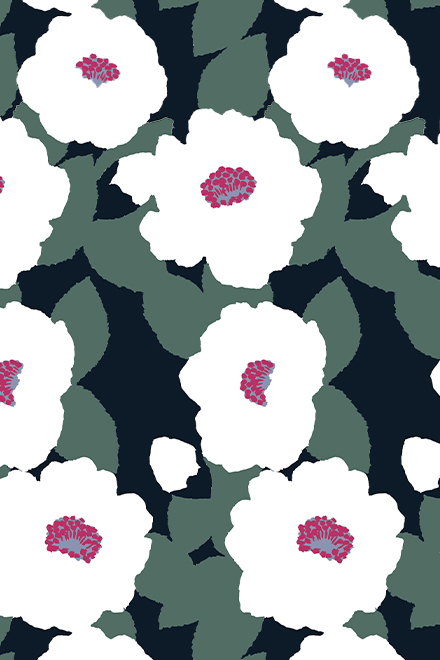
山茶花は ピンクや赤のものが多いが
白の雪山(せつざん)と呼ばれる
美しいものがある。
優雅なその姿は 濃い緑の中で
目に あざやか。
寒い冬の日に
見るのが楽しみな花のひとつ。
(脇阪 克二)
"White Camellia"(2017,by Katsuji Wakisaka)
Camellias blooms is common in pink and red.
And yet, there is a white variety called Snow mountain.
These pure beauty bloom in freezing winter,
Set against glossy dark green leaves,
Please the eye and gladden my heart.
| English translation by LI XIAO XIAO |
"Setsuzan"(2017, par Katsuji Wakisaka)
Il y a beaucoup de camélias rose et rouge mais
il existe une fleur magnifique du nom de Setsuzan.
Sa silhouette gracieuse attire l’oeil dans une forêt verte.
Elle fait partie des fleurs dont on se fait un plaisir de voir
pendant les longs jours froid de l’hiver.
| Traduction française par Jean-Baptiste Fauvel Matsumoto |
"春蘭"(2017, 脇阪 克二)
山茶花的種類以粉色和紅色居多
有一種純白色的山茶花,在日本名爲「雪山」
它們風姿優雅.濃綠中開得潔白自在
是寒冬裡一抹賞心悅目的風景
| 中譯 : 李 瀟瀟 |
→こちらのテキスタイルデザイン商品
(Textile products with this pattern)
平成29年11月13日 月曜日号
“桔梗 平成24年”
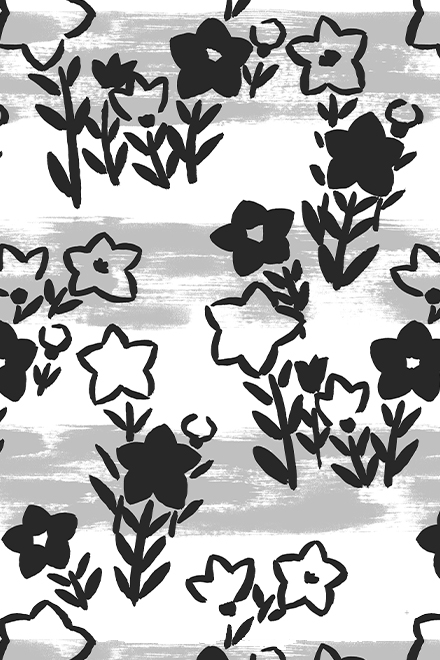
風船のような丸い蕾がパッと開いて
大きな星形のうす紫の花が咲く。
花の形や色が日本的で
「万葉集」で秋の七草として詠われている。
(脇阪 克二)
"Chinese bellflower"(2012,by Katsuji Wakisaka)
Balloon-shaped round flower buds,
Burst into star-shaped light purple bloosoms.
As one of the seven flowers of autumn, Chinese bellflower has a typical Japanese shape and traditional color.
They was described in "Manyoshu" (Collection of Ten Thousand Leaves) poetry.
| English translation by LI XIAO XIAO |
"Campanule chinoise"(2012, par Katsuji Wakisaka)
Des bourgeons de formes rondes comme des montgolfières
éclosent en des fleurs violettes en forme d’étoiles.
La campanule chinoise est une fleur typiquement japonaise
de par sa forme et sa couleur, décrite dans le Manyoshu,
recueil de poésie classique japonais.
| Traduction française par Jean-Baptiste Fauvel Matsumoto |
"桔梗"(2012, 胁阪 克二)
氣球般圓鼓鼓的花蕾,砰地綻出一大朵淡紫色的星形桔梗花。
因其花形和顏色符合日本傳統審美,
桔梗早在《萬葉集》中就被詠誦為秋天七草之一。
| 中译 : 李 瀟瀟 |
→こちらのテキスタイルデザイン商品
(Textile products with this pattern)
平成29年11月11日 土曜日号
“錦 平成24年”
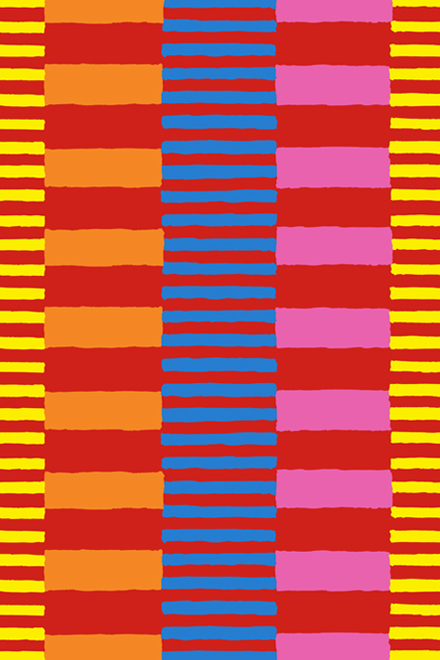
金銀、珊瑚、綾錦といわれたように錦は宝物として
大切にされた。
素材の豪華さと
色鮮やかな色彩の織物は人々の目を奪った。
錦絵、錦鯉、もみじの錦などのように
心を虜にするような美しいものに使われている。
(脇阪 克二)
"Nishiki"(2012,by Katsuji Wakisaka)
Nishiki, or brocade is a class of richly decorative shuttle-woven textile, which is also called gold-and-silver textile, coral fabric, or aya-nishiki(costly fabric).
Brocade is made of luxurious fabrics and has brilliant colors.
Words include "nishiki" are often used to describe gorgeous things such as nishiki-e(brocade picture), nishiki-goi(cyprinus carpio haematopterus), and nishiki autumn maple trees.
| English translation by LI XIAO XIAO |
"Nishiki"(2012, par Katsuji Wakisaka)
Nishiki, « brocart », est un tissu de haute fabrique de Kyoto,
autrement appelé tissu or-argent, tissu de corail et tissu de luxe.
La magnificence de sa matière première et ses couleurs somptueuses
en éblouissent ses observateurs.
Ce terme est souvent utilisé pour décrire une beauté captivante,
tel que nishiki-e, « gravure brocart » ou nishiki-koi, « carpe commune ».
| Traduction française par Jean-Baptiste Fauvel Matsumoto |
"錦"(2012, 胁阪 克二)
錦貴爲瑰寶,又被稱作金銀、珊瑚、綾錦。
奢華的布料配上色澤鮮豔的紋樣,豔麗奪目。
錦常用來比喻動人心弦的美麗事物。
例如,錦繪、錦鯉魚、錦紅楓等。
| 中译 : 李 瀟瀟 |
→こちらのテキスタイルデザイン商品
(Textile products with this pattern)
平成29年11月04日 土曜日号
“森のおはなし 平成17年”
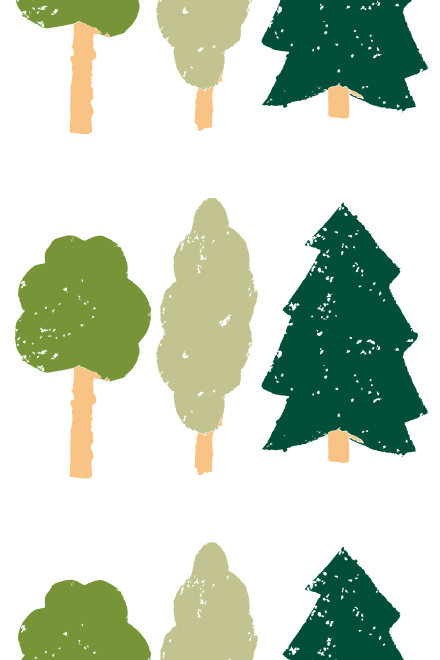
森の中に入るといろんな音が聞こえてくる。
小鳥がさえずり、大きな鳥もひと声鳴いてバタバタと飛んでいく。
足元では落葉がカサカサカサ。
風が吹くとザワザワと木々がゆれる。
お日さまが出ると、こもれびがきらきらと輝き、あいさつし合っている。
森の中ではいろんなお話が聞こえてくる。
(脇阪 克二)
"Forest’s talk"(2005,by Katsuji Wakisaka)
Listen, there are little talks in the forest.
Little birds chatters, tweet, tweet;
Big birds cackles, flapping their wings and fly away.
Stepping on the fallen leaves, crunch, crunch;
Branches of trees, murmuring in the wind.
Sun beams streamed through the leaves, flickering lights greetings to each other.
Listen, there are interesting talks in the forest!
| English translation by LI XIAO XIAO |
"Une histoire de forêt"(2005, par Katsuji Wakisaka)
Quand on rentre dans une forêt, on entend une multitude de sons.
De petits oiseaux chantent, alors que de grands oiseaux s’envolent en croassant.
Le bruissement des feuilles sur lesquelles on marche.
Lorsque le vent se lève, les arbres s’agitent de tout leur long.
Lorsque le soleil se lève, les rayons de soleil nous saluent en transperçant les feuilles.
Quand on rentre dans une forêt, on entend une multitude d’histoires.
| Traduction française par Jean-Baptiste Fauvel Matsumoto |
"森林物語"(2005, 脇阪 克二)
走進森林洗耳傾聽,四周傳來各種聲音。
小鳥嘰嘰、喳喳;大鳥呷呷,扑騰飛走。
踩踏樹葉,唰唰、唰唰;
風吹樹枝,簌簌、莎莎。
太陽出來,陽光從樹葉間射落,清脆交疊,相互問好。
森林裡充滿著自然之可愛對話。
| 中譯 : 李 瀟瀟 |
→こちらのテキスタイルデザイン商品
(Textile products with this pattern)
平成29年11月01日 水曜日号
“大和撫子 平成19年”
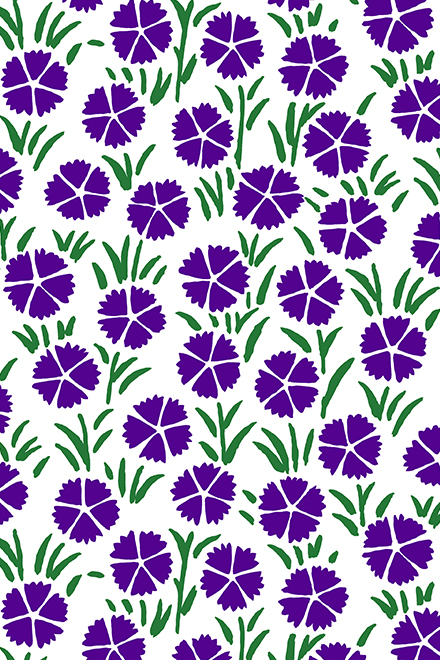
撫子の花は小さく派手さはなく、秋の野が似合う。
秋の七草のひとつであり、その清楚な美しさから
日本女性を表す言葉として知られている。
撫子の花のように、けなげでつつましやかな
美しさを育んでいってほしい。
(脇阪 克二)
"Feminine beauty"(2007,by Katsuji Wakisaka)
Dianthus superbus flowers, one of the seven flowers of autumn,
Simple but elegant, blending perfectly with the landscape.
They are used to express Japanese beauty.
Girls in Japan are expected to be educated like dianthus superbus,
With an admirable and feminine beauty.
| English translation by LI XIAO XIAO |
"Oeillet du Japon"(2007, par Katsuji Wakisaka)
L’Oeillet est une petite fleur simple, à qui l’automne va si bien.
Faisant partie des sept fleurs principales de l’automne,
Elle est connue pour faire référence à la femme japonaise,
de par sa grâce et sa beauté.
À l’image de l’oeillet, on lui souhaite de cultiver sa beauté,
héroïquement et humblement.
| Traduction française par Jean-Baptiste Fauvel Matsumoto |
"瞿麥花"(2007, 胁阪 克二)
瞿麥花小巧素雅,襯於秋天的原野,
作為秋七草之一,
因此常以瞿麥花喻日本女性。
在日本,女孩被教導要擁有瞿麥花一般素淨典雅、堅毅勇敢的品格。
| 中译 : 李 瀟瀟 |
→こちらのテキスタイルデザイン商品
(Textile products with this pattern)
平成29年10月31日 火曜日号
“菊だより 平成24年”

菊は主に秋に咲くが一年中どこかで
見ることが出来る。日本の気候や
日本人の気質にも合っている。
御紋は菊だし仏様への花も菊であることが多い。
菊のたよりが聞かれる秋
日本人であることを思い起こし
自分自身を見つめ直したい。
(脇阪 克二)
"Chysanthemum days"(2012,by Katsuji Wakisaka)
Chrysanthemum burst in autumn, even though we can see them all year long.
As a symbol of Japan, it represents Japanese people in some way.
Chrysanthemum on the family crests, chrysanthemum in front of a Buddhist altar.
It informs me autumn is coming,
It reminds me my identity as a Japanese.
| English translation by LI XIAO XIAO |
"Chrysanthème"(2012, par Katsuji Wakisaka)
Les chrysanthème fleurissent en général en automne,
mais on peut en voir tout au long de l’année.
Ils sont en adéquation avec le climat et le tempérament des japonais.
Très souvent, les sceaux ont pour signe le chrysanthème, comme Buddha.
L’automne annoncé par la floraison des chrysanthèmes
nous rappelle notre identité japonaise, nous donnant l’envie de
retrouver nos racines.
| Traduction française par Jean-Baptiste Fauvel Matsumoto |
"秋菊教我們的事"(2012, 胁阪 克二)
菊開最盛在秋天。
在日本,一年四季都有菊。
家紋裡有菊,佛壇供奉的也是菊。
菊教我們秋天的來臨,
菊也教我身為日本人的自我認同。
| 中译 : 李 瀟瀟 |
→こちらのテキスタイルデザイン商品
(Textile products with this pattern)
平成29年10月27日 金曜日号
“天竺牡丹 平成24年”
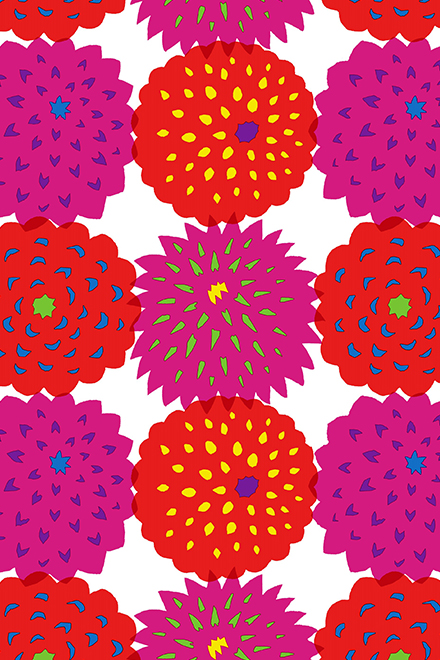
ピンク、赤、紅、紫、黄、オレンジなどの色が鮮やか。
つやのある花弁が競うように重なりあって輝やいている。
天竺牡丹(ダリア)は西洋的でもあり東洋的でもあり
エキゾチックで情熱的な魅力をたたえている。
(脇阪 克二)
"Dahlia"(2012,by Katsuji Wakisaka)
Pink, red, purple, yellow, orange…
Dahlia blooms in vivid colors.
Overlapping petals charming and bright.
Dahlia blooms in Western and Eastern,
Sending forth its exotic charm.
| English translation by LI XIAO XIAO |
"Dahlia"(2012, par Katsuji Wakisaka)
Ses couleurs vives comme le rose, le rouge, le pourpre, le violet, le jaune ou le orange.
Ses nombreux pétales brillants donnent l’impression qu’ils se concurrencent.
Le Dahlia est tant une fleur occidentale qu’orientale, exotique et charmante.
| Traduction française par Jean-Baptiste Fauvel Matsumoto |
"天竺牡丹"(2012, 胁阪 克二)
粉的,紅的,紫的,黃的,橙的,鮮豔剔透。
花瓣重重疊疊,繽紛吐艷。
天竺牡丹開遍了西方東方,
神秘而熱情是她獨具的魅力。
| 中译 : 李 瀟瀟 |
→こちらのテキスタイルデザイン商品
(Textile products with this pattern)
平成29年10月25日 水曜日号
“ひらがな 平成29年”
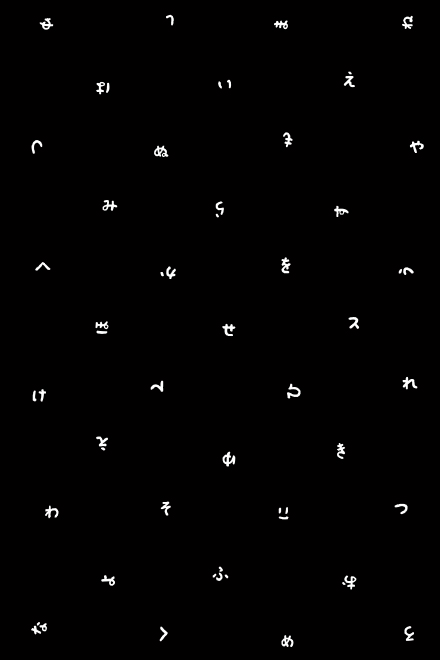

ひらがなを筆で描く
いつもの 僕の ボテッとした字で。
空間を いっぱいにとって
小さな ひらがなを 並べていく。
一見 無地のような空間に
目の検査のように
ひらがなが あちこち向きながら
表情を与えている。
(脇阪 克二)
"Hiragana "(2017,by Katsuji Wakisaka)
I kept writing hiragana (basic Japanese phonetic script) with a calligraphy pen,
Lining up my little podgy fonts to fill the space.
They are like some marks on the visual chart,
Facing different directions,
Performing a vivid dance on the plain background.
| English translation by LI XIAO XIAO |
"Hiragana"(2017, par Katsuji Wakisaka)
J’écris les hiraganas au pinceau,
Avec des traits toujours aussi épais.
J’aligne les petits signes,
en laissant de nombreux espaces blancs.
À l’image des tests ophtalmologiques,
Dans un espace uni à première vue
Jaillissent un peu partout des hiraganas,
Nous faisant sourire de toute part.
| Traduction française par Jean-Baptiste Fauvel Matsumoto |
"日文平假名"(2017, 胁阪 克二)
我用毛筆書寫日文平假名,一貫渾圓的字體。
在大片的空白裡,排布小小的假名。
白底無紋的背景中,
這些手寫平假名如視力檢測符號一般,
朝向各異,生動有趣。
| 中译 : 李 瀟瀟 |
→こちらのテキスタイルデザイン商品
(Textile products with this pattern)
平成29年10月14日 土曜日号
“雲間がくれ 平成24年”

飛行機の窓から見える外は雲がかかっている。
窓に顔を近づけてのぞきこむと
雲の間から下の風景が垣間見える。
山や川がある。森や畑も見える。
人の営みや自然の風景が
移り変っていくのを見るのは楽しい。
(脇阪 克二)
"Between the clouds"(2012,by Katsuji Wakisaka)
Viewing through an airplane window,
There hanging overcome clouds/
Furthermore, I approached to the window and overlooked,
Wow, I caught a glimpse of the landscape!
Mountains, rivers, forests and farm fields…
People's activities and the workings of nature change frequently between the clouds。
| English translation by LI XIAO XIAO |
"Caché par les nuages"(2012, par Katsuji Wakisaka)
Par le hublot d’un avion, on peut voir des nuages dehors.
En rapprochant son visage pour mieux y voir,
On peut voir par intermittence le paysage à travers les nuages.
Des montagnes et des rivières, ainsi que des forets et des champs.
C’est amusant de voir les mouvements changeant
des hommes en pleine action et de la nature calme.
| Traduction française par Jean-Baptiste Fauvel Matsumoto |
"隱雲間"(2012, 胁阪 克二)
從機窗望出去,雲層輕掛。
貼近窗口俯瞰,雲縫間窺見地面的景象。
山川河流,森林田野。
人所努力經營的自然,
與造物主排布的自然,
在雲間隱現,交錯延展,頗為有趣。
| 中译 : 李 瀟瀟 |
→こちらのテキスタイルデザイン商品
(Textile products with this pattern)
平成29年10月11日 水曜日号
“白菊 平成18年”
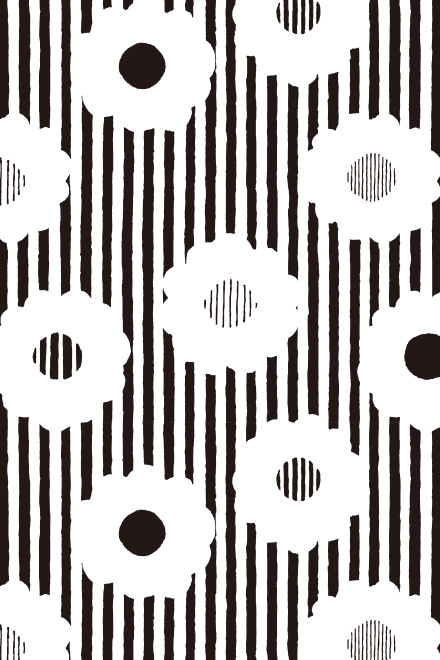
散歩している雑草の中に点々と小さい白い菊が並んでいる。
ひっそりと、しかし一心に上を向いて
咲いているそのことが、とても美しいと思う。
(脇阪 克二)
"White chrysanthemum"(2006,by Katsuji Wakisaka)
I saw those white chrysanthemum while taking a talk.
They are small and quite, but growing straight towards the sky.
Seeing someone earnestly try their hardest like this is wonderful.
| English translation by LI XIAO XIAO |
"Chrysanthème blanc"(2006, par Katsuji Wakisaka)
En se promenant dans les mauvaises, on remarque des petits chrysanthèmes blancs par endroit.
Silencieusement mais de toute leur force, il se dresse de tout leur haut,
me rappelant ainsi toute la beauté d’une fleur qui fleurit et s’épanouit.
| Traduction française par Jean-Baptiste Fauvel Matsumoto |
"白菊"(2006, 脇阪 克二)
散步途中發現雜草中的點點白菊
並不起眼,卻一新向上不低頭
那用盡全力開花的自然姿態,格外美好
| 中譯 : 李 瀟瀟 |
→こちらのテキスタイルデザイン商品
(Textile products with this pattern)
平成29年10月07日 土曜日号
“よろこび 平成28年”
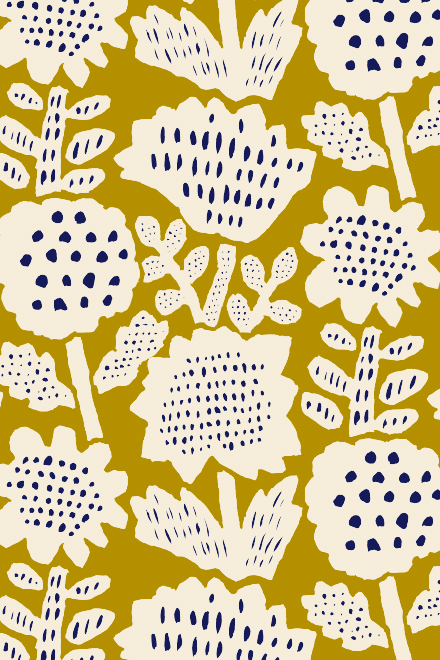
太陽の光り、新鮮な空気、
いっぱいの緑、色とりどりの花。
今を生きている よろこび。
(脇阪 克二)
"Joy"(2016,by Katsuji Wakisaka)
Bright sunshine, fresh air,
Green field with vivid flowers in mass of colors.
Live for today, joy of the real moments.
| English translation by LI XIAO XIAO |
"La joie"(2016, par Katsuji Wakisaka)
La lumière du soleil, l’air frais,
une verdure dense, des fleurs multicolores.
La joie de vivre l’instant présent.
| Traduction française par Jean-Baptiste Fauvel Matsumoto |
"喜悅"(2016, 脇阪 克二)
太陽的光熱,空氣的澄澈
綠意的生機,花的繽紛
一切都是活在當下的生命的喜悅
| 中譯 : 李 瀟瀟 |
→こちらのテキスタイルデザイン商品
(Textile products with this pattern)
平成29年10月04日 水曜日号
“秋桜 平成29年”
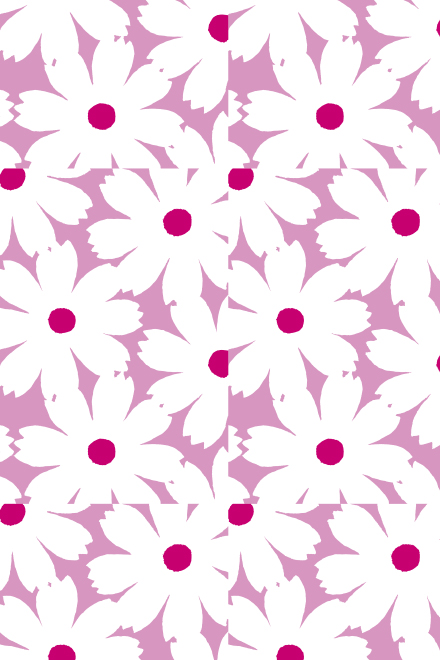
秋になると桃色、白、赤などの
秋桜を大ぜいの人が
見に行っている映像が流れる。
メキシコからの外来種だが
日本人にはとても親しまれ
愛される花になっている。
秋桜という漢字は日本人の心を
とらえる表記だが
これはさだまさしの歌が
きっかけになって定着していったそうだ。
(脇阪 克二)
"Cosmos flower"(2017,by Katsuji Wakisaka)
Pink, white, red... It's the best season for viewing cosmos.
Hundreds of thousands of people come to share the magnificent scenery.
Cosmos is an introduced species from Mexico, which is commonly known and loved by Japanese people.
It is called "Akizakura", Aki=autumn and Zakura=Cherry blossom in kanji, means cherry blossoms of autumn.
Cosmos became popular in Japan with a song witten by Masashi Sada.
| English translation by LI XIAO XIAO |
"Les cosmos"(2017, par Katsuji Wakisaka)
À l’automne, il y a beaucoup d’images
de groupes de personnes allant admirer
les cosmos pêches, blanches ou rouges.
Bien que d’origine mexicaine, cette fleur
est très proche des japonais qui l’adorent.
« Akizakura » est un mot très touchant pour les japonais.
De plus, il est dit que les chansons de Sada Masashi
ont été produites grâce à ces fleurs.
| Traduction française par Jean-Baptiste Fauvel Matsumoto |
"秋櫻(波斯菊)"(2017, 胁阪 克二)
粉的白的紅的,繽紛的波斯菊開在秋天的郊外,觀者如市。
波斯菊是墨西哥引進的外來品種,
在日本漢字表記作“秋櫻”,為人們所喜愛。
秋櫻的廣爲流傳源於佐田雅志作詞作曲,山口百惠演唱的那首《秋櫻》。
| 中译 : 李 瀟瀟 |
→こちらのテキスタイルデザイン商品
(Textile products with this pattern)
平成29年09月30日 土曜日号
“菊水 平成17年”
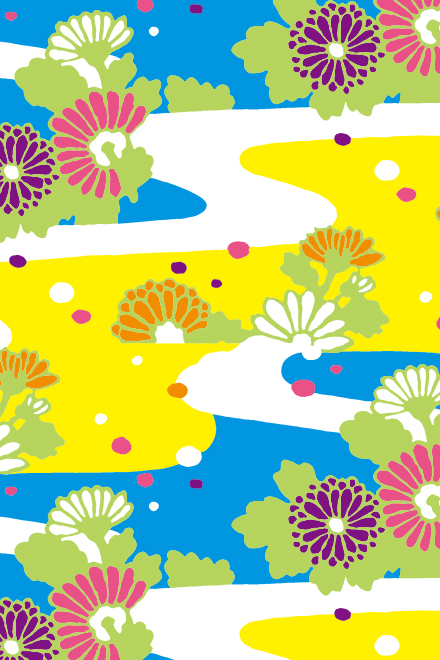
菊に水の流れという昔からある
日本の模様をシンプルに、
そして色を新しくして表現した。
昔からの模様にはいいものがいっぱいある。
それをどう生かしていくかが課題だ。
(脇阪 克二)
"Flowing chrysanthemum"(2005,by Katsuji Wakisaka)
Chrysanthemum with stream is a traditional pattern in Japan.
I painted it in a simple way but with new color arrangement.
There are numerous fantastic old pattern, into which we should inject new life.
| English translation by LI XIAO XIAO |
"Kikusui"(2005, par Katsuji Wakisaka)
J’ai simplifié et recoloré l’ancien motif japonisant
appelé kikusui, qui renvoie au courant de l’eau sur
les chrysanthèmes japonais.
Il existe de très nombreux jolis motifs d’antan.
La question est de savoir comment les transcender.
| Traduction française par Jean-Baptiste Fauvel Matsumoto |
"菊水"(2005, 胁阪 克二)
菊與流水古來有之。
我將這日本傳統紋樣調配新色,賦予它簡潔而嶄新的表現。
古文樣中有無窮的美,
如何發覺這些美,並喚起新生,
是我們現代人的使命。
| 中译 : 李 瀟瀟 |
→こちらのテキスタイルデザイン商品
(Textile products with this pattern)
平成29年09月28日 木曜日号
“茄子 平成27年”
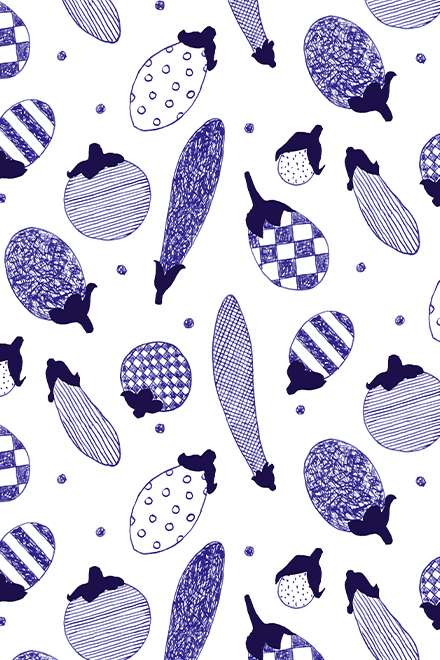
食物で何が好きかと問われれば
茄子と答える。
煮物もいいし田楽は最高。
ぬか漬けも好きだ。
茄子紺といわれる
少し紫がかった紺色も好きで
服は白か茄子紺を好んで着ている。
母も茄子が好きだった。
(脇阪 克二)
"Nasu / Eggplants"(2015,,by Katsuji Wakisaka)
"What is your favorite food?"
If I am asked, I will say "nasu (eggplants)"
They are good eaten stewed, and dengaku( grilled eggplants with sweet miso paste) are amazing.
I like nukazuke ( rice-bran pickles) too.
I like the color called "nasu-kon" which is purplish navy blue, and I often wear the colors nasu-kon or white by preference.
My mother also liked eggplants.
| English translation by Yuka Mamekoshi |
"Aubergine"(2015, par Katsuji Wakisaka)
S’il m’est demandé quelle serait ma nourriture préférée,
je répondrais les aubergines.
Marinées, elles sont délicieuses.
Grillées avec du miso, elles sont excellentes.
J’aime aussi quand elles sont marinées dans le vinaigre.
J’aime également les nasu-kon avec sa couleur violette,
que j’apprécie porter tout comme le blanc.
Ma mère aimait également les aubergines.
| Traduction française par Jean-Baptiste Fauvel Matsumoto |
"茄子"(2015, 胁阪 克二)
若被問起喜歡什麼食物,
我定會毫不猶豫回答,茄子。
清水煮好吃,田樂茄子更是絕品,
啊對了,醃製成漬物也不錯。
有種顏色叫『茄子紺』,是泛紫的藍色。
我就連平時愛穿的衣服顏色,也是除了白色就數茄子紺。
說起來我母親也很鍾愛茄子吶。
| 中译 : 李 瀟瀟 |
→こちらのテキスタイルデザイン商品
(Textile products with this pattern)







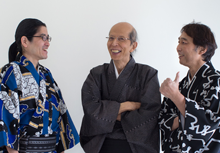

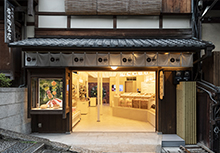

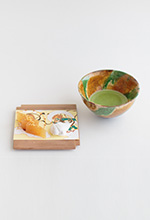
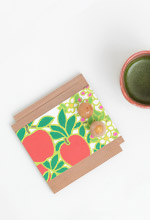
 お問い合わせ窓口
お問い合わせ窓口